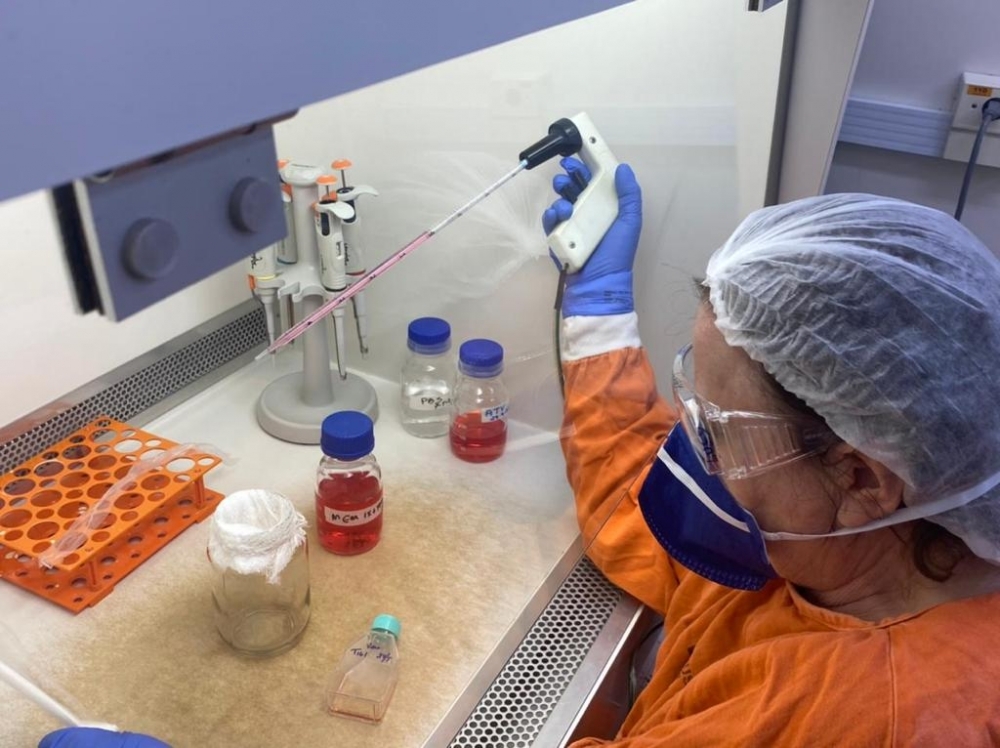

Researchers at the University of São Paulo conducted experiments with blood plasma from 60 volunteers infected in 2020 by SARS-CoV-2 lineage B.1.1.28. In 84% of cases, antibodies in the samples neutralized the Gamma variant in cultured cells (photo: researchers’ archive)
Researchers at the University of São Paulo conducted experiments with blood plasma from 60 volunteers infected in 2020 by SARS-CoV-2 lineage B.1.1.28. In 84% of cases, antibodies in the samples neutralized the Gamma variant in cultured cells.
Researchers at the University of São Paulo conducted experiments with blood plasma from 60 volunteers infected in 2020 by SARS-CoV-2 lineage B.1.1.28. In 84% of cases, antibodies in the samples neutralized the Gamma variant in cultured cells.

Researchers at the University of São Paulo conducted experiments with blood plasma from 60 volunteers infected in 2020 by SARS-CoV-2 lineage B.1.1.28. In 84% of cases, antibodies in the samples neutralized the Gamma variant in cultured cells (photo: researchers’ archive)
By Karina Toledo | Agência FAPESP – Laboratory tests conducted at the University of São Paulo’s Institute of Tropical Medicine (IMT-USP) in Brazil suggest that in the vast majority of cases the antibodies produced during an infection by the ancestral strain of the novel coronavirus can also neutralize the variant P.1 (now called Gamma), which emerged in November 2020 in Manaus, Amazonas state, and is considered more transmissible.
The experiments were performed on blood plasma collected in May and June of last year from 60 volunteers infected by SARS-CoV-2 lineage B.1.1.28, the first variant detected in Brazil. In 84% of the cases, the antibodies present in samples collected after the 15th day of infection neutralized P.1 in cultured cells.
The study was funded by FAPESP. The full findings were reported in an article posted to the preprint platform medRxiv and now being peer-reviewed.
“The findings suggest that individuals infected by the ancestral strain of SARS-CoV-2 tend to be more protected against P.1. This doesn’t rule out reinfection, symptomatic disease or even death, but it does offer a message of hope at a very difficult time,” Maria Cassia Mendes-Correa, a professor at the University of São Paulo’s Medical School (FM-USP) and first author of the article, told Agência FAPESP.
The study was conducted under the aegis of the Corona São Caetano Program, an online platform offering COVID-19 care to residents of São Caetano do Sul (a city in metropolitan São Paulo) via remote monitoring and home visits to collect samples for diagnosis. The initiative involves the Municipal University of São Caetano do Sul (USCS), the city government, the startup MRS Modular Research System, and IMT-USP (more at: www.medrxiv.org/content/10.1101/2020.06.23.20138081v1.full.pdf).
After having the diagnosis confirmed by RT-PCR testing, the 60 volunteers with mild symptoms included in the study were monitored for 42 days and had blood samples taken for serological profile analysis. Each blood sample was submitted to a virus neutralization test (VNT), which entails culturing SARS-CoV-2 and hence requires a laboratory with a high level of biosafety.
Unlike regular laboratory tests to detect IgM (immunoglobulin M, the first antibody produced in the acute stage) and IgG (immunoglobulin G, which appears at the end of the acute stage), the VNT technique measures the amount of neutralizing antibodies, which bind to the tip of the spike protein used by the virus to invade and infect human cells. This region of the protein is known as the receptor-binding domain (RBD).
The variant P.1 has caused concern because it displays mutations in the spike protein, some of which are in the RBD. “Neutralizing antibodies are one of the organism’s main weapons against viruses. Their production ramps up gradually until the amount is sufficient to abort the infection. In most patients, the curve rises in the first two weeks and then remains stable,” Mendes-Correa said.
In the tests conducted with B.1.1.28, antibodies in plasma collected from 56 volunteers (90%) neutralized the virus in the laboratory. In the case of P.1, samples from 50 participants (84%) did so. In both cases, not until over a fortnight after the onset of infection were there enough neutralizing antibodies to combat the virus, and their performance against the ancestral strain was superior in every stage of the analysis.
“It’s important to bear in mind that the tests used plasma collected in 2020, so we can’t be sure these people would be equally well-protected now. Neutralizing antibodies, like IgG and IgM, tend to decay over time,” Mendes-Correa said.
To see if the protection has lasted, the IMT-USP group is now repeating the trials with plasma samples collected from the same volunteers 180 days after infection. The results of this second stage of the study will be published soon.
In addition, the researchers are testing the plasma collected in 2020 against other variants of concern, such as B.1.1.7 (the UK or Alpha variant) and B.1.351 (the South African or Beta variant).
While neutralizing antibodies are one of the immune system’s primary weapons against the virus, they are not the only ones. “Cellular immunity, mediated by lymphocytes [cells that recognize and destroy pathogens], is another mechanism involved in the body’s defense against SARS-CoV-2, and also constitutes an important tool in this process. We believe the two mechanisms combined will enable us to rid ourselves of pathogens,” Mendes-Correa said.
The article “Individuals who were mildly symptomatic following infection with SARS-CoV-2 B.1.1.28 have neutralizing antibodies to the P.1 variant” is at: www.medrxiv.org/content/10.1101/2021.05.11.21256908v1.
Republish
The Agency FAPESP licenses news via Creative Commons (CC-BY-NC-ND) so that they can be republished free of charge and in a simple way by other digital or printed vehicles. Agência FAPESP must be credited as the source of the content being republished and the name of the reporter (if any) must be attributed. Using the HMTL button below allows compliance with these rules, detailed in Digital Republishing Policy FAPESP.




